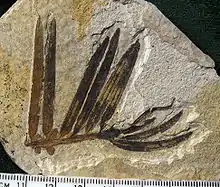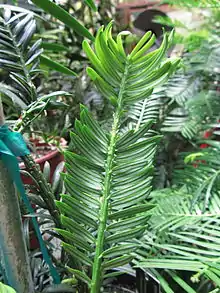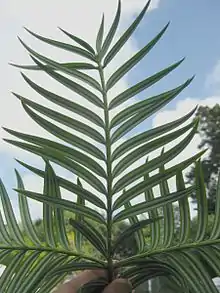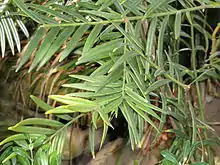Amentotaxus
Amentotaxus is a genus of conifers (catkin-yews) comprising five species, treated in either the Cephalotaxaceae, or in the Taxaceae when that family is considered in a broad sense. The genus is endemic to subtropical Southeast Asia, from Taiwan west across southern China to Assam in the eastern Himalaya, and south to Vietnam. The species are evergreen shrubs and small trees reaching 2–15 m tall.
| Amentotaxus | |
|---|---|
 | |
| Fossil Amentotaxus needles | |
| Scientific classification | |
| Kingdom: | Plantae |
| Clade: | Tracheophytes |
| Division: | Pinophyta |
| Class: | Pinopsida |
| Order: | Pinales |
| Family: | Taxaceae |
| Genus: | Amentotaxus Pilg. |
| Species | |
|
Amentotaxus argotaenia | |
.jpg.webp)
The leaves are spirally arranged on the shoots, but twisted at the base to lie in two flat ranks (except on erect leading shoots); they are linear-lanceolate, 4–12 cm long and 6–10 mm broad, soft in texture, with a blunt tip, green above, and with two conspicuous white stomatal bands below. They differ from the related genus Cephalotaxus in the broader leaves, and from Torreya by the blunt, not spine-tipped leaves.
The species can be either monoecious or dioecious; when monoecious, the male and female cones are often on different branches. The male (pollen) cones are catkin-like, 3–15 cm long, grouped in clusters of two to six together produced from a single bud. The female (seed) cones are single or grouped a few together on short stems; minute at first, they mature in about 18 months to a drupe-like structure with the single large nut-like seed 1.5–3 cm long surrounded by a fleshy covering, orange to red at full maturity; the apex of the seed usually protrudes slightly out of the fleshy covering.
The oldest fossils that are recognisable to the genus are from the Middle-Late Jurassic Daohugou Bed of China.[1]
Extant species
| Image | Scientific name | Common name | Distribution |
|---|---|---|---|
 | Amentotaxus argotaenia | Catkin yew | China: Fujian, southern Gansu, Guangdong, Guangxi, Guizhou, western Hubei, Hunan, Jiangsu, north-western Jiangxi, central and south-eastern Sichuan, south-eastern Tibet and southern Zhejiang |
| Amentotaxus assamica | Assam catkin yew | India | |
 | Amentotaxus formosana | Taiwan catkin yew | Taiwan |
| Amentotaxus hatuyenensis | Vietnam | ||
| Amentotaxus poilanei | Poilane's catkin yew | Vietnam | |
 | Amentotaxus yunnanensis | Yunnan catkin yew | Laos, Vietnam, and Guizhou and Yunnan in China |
References
- Dong, Chong; Shi, Gongle; Herrera, Fabiany; Wang, Yongdong; Herendeen, Patrick S; Crane, Peter R (2020-06-18). "Middle–Late Jurassic fossils from northeastern China reveal morphological stasis in the catkin-yew". National Science Review. 7 (11): 1765–1767. doi:10.1093/nsr/nwaa138. ISSN 2095-5138.
External links
 Media related to Amentotaxus at Wikimedia Commons
Media related to Amentotaxus at Wikimedia Commons Data related to Amentotaxus at Wikispecies
Data related to Amentotaxus at Wikispecies- Gymnosperm Database
- Flora of China
